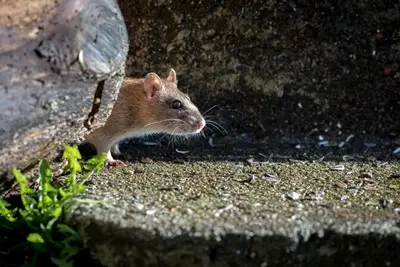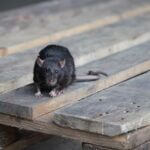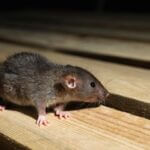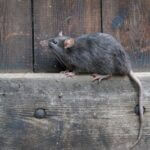Pet and wild rats are different species, so you can’t keep a wild rat as a pet. Although they have a similar body structure and appearance, their lifestyle, behavior, color, and adaptations diverge.
Pet rats are Norway rats, which are white, black, tan, gray, or beige. Wild rats are roof rats (also called black rats and ship rats) with little coloring and patterns with puffier fur.
Wild rats are aggressive and antisocial, while pet rats are domesticated to be sociable with humans.
Pet rats have been domesticated over several generations and through cross-breeding. So, they’ve lost many of their instincts, natural habits, and disease risk.
You can’t tame wild rats and transform them into pet rats, as it would require multiple generations of breeding and adaptation to achieve this goal.
What Is The Difference Between Pet Rats And Wild Rats?
Here are the main differences between pet rats and wild rats:
- Species
- Size
- Color
- Posture
- Eye and ear shape
- Adaptation
- Social behavior
- Fur behavior
- Lifespan
- Disease risk
A pet rat isn’t a domesticated wild rat and shouldn’t be treated as such.
Here is a table describing the significant differences:
| Pet Rat | Wild Rat | |
| Species | Norway rat (Rattus Norvegicus domestica) | Roof rat (Rattus rattus) |
| Lifespan | 2-4 years | Less than a year (1 year) |
| Size | 11-12 inches | 9-10 inches |
| Color | White, black, tan, gray, and beige | Brown or black |
| Eyes, Ears & Tail | Relaxed eyelids, large and rounded ears, and long tail | Well-rounded eyes, rigid ears, and short tail |
| Stance and Posture | Relaxed with minimal motion | Standing on all fours and always on the move |
| Fur Behavior | Do not puff fur unless scared | Like to puff their fur |
| Social Behavior | Calmer and friendlier | Antisocial toward humans and other animals |
| Adaptation | Struggle to survive in the wild, but do well in captivity | Respond frantically to environmental change |
| Disease risks | Minimal disease-carrying risks | High risk of spreading diseases |
Are Pet Rats The Same As Wild Rats?
Pet rats and wild rats are different from each other.
They don’t belong to the same species, which is their primary point of divergence. Aside from that, they have several visual and behavioral differences, including:
Size And Lifespan
Pet rats usually have smaller bodies than their wild counterparts but eventually grow larger.
Pet rats have a longer lifespan (2-4 years vs. 1 year), allowing them to grow to their full potential. They’re safeguarded against predators and receive ample food and water from their owners.
Wild rats may only appear larger when puffing up their fur to scare away predators. Some wild rats are outliers, reaching up to 20 inches in length.
Coloring And Patterns
Pet rats are found in various colors, mainly due to cross-breeding. They can be:
- White
- Black
- Tan
- Gray
- Beige
This is matched to different color patterns, which include:
- Striped
- Hooded
- Spotted
- Hooded
Wild rats have no such variety. They can be:
- Black
- Grey
- Brown
Dark coloring works as camouflage to protect the wild rats from predators.
Sometimes, a feral rat may have a white underbelly, but the rest of the body will remain black or brown. Without cross-breeding, diverse coloring can’t develop.
Can Wild Rats Be Black And White?
Wild rats don’t have a black and white coloring. A wild rat will either be black, gray, or brown. Wild rats don’t naturally develop a black-and-white color because it harms their ability to camouflage.
Wild rats usually have the same-colored fur throughout. However, some wild rats may have white or light brown underbellies, which may not be noticeable initially.
If you see a black and white wild rat, it’s probably a cross-breed with a pet rat. Moreover, it would need to have been a product of several generations.
The black and white coloring wouldn’t arrive in 1-2 generations, let alone immediately.
Behavior
Wild rats are always on the lookout for danger, making them skittish and fearful. This instinctual behavior maximizes their longevity in unsafe conditions.
If cornered, a wild rat will fight its way out and bite you. This species prefers to avoid human interaction at all costs. Given the chance, they’d sooner run away from you than fight.
Roof rats react frantically to light and sound and are more cautious of unfamiliar food.
Pet rats are much friendlier toward humans. You can touch and hold a pet rat with little risk of getting bitten or scratched. Depending on their training, they can bond with pets and owners.
This friendly and sociable behavior is a result of long-term domestication.
According to Frontiers in Zoology, this is similar to evolution because it results in behavioral and genetic alterations. Pet rats have fewer wild traits, retaining only a few original instincts.
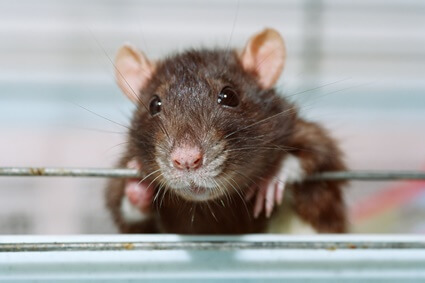
Disease Risk
Wild rats carry deadly diseases, including leptospirosis, salmonella, listeria, toxoplasma gondii, typhus, the plague, and hantavirus. They are usually exposed to these diseases through feces, urine, and bites.
Pet rats aren’t considered a disease threat and carry fewer parasites (fleas, ticks, lice, and mites). They undergo rigorous testing to ensure they don’t have any diseases before being sold as pets.
Veterinarians isolate and treat sick pet rats to reduce the spread of deadly diseases.
Can You Tame Wild Rats?
You can’t tame wild rats and shouldn’t attempt to keep one as a pet.
Wild rats aren’t sociable or friendly around humans. They’ll constantly seek to hide when exposed to open areas or the attention of other animals.
They display aggressive behaviors when threatened and will respond by:
- Fighting.
- Biting.
- Chasing.
- Boxing.
According to the International Journal of Current Research and Review, wild rats are among the most dangerous and destructive pests.
Aside from that, wild rats react frantically when moved from their natural habitat. Taking a wild rat into captivity will cause untold stress.
Moreover, wild rats are dangerous to humans and household pets. They can transmit various illnesses directly and indirectly in the following ways:
- Bites.
- Scratches.
- Urine.
- Poop.
- Saliva.
For these reasons, you shouldn’t attempt to tame a wild rat.
Can You Keep A Wild Baby Rat As A Pet?
You can’t keep a wild baby rat as a pet. According to the Medical College of Wisconsin, domestication involves many genetic changes.
This means it’s difficult to change the genomics of a wild rat by adopting it. Domesticating a wild rat will take several generations, and cross-breeding with pet rats.
A wild baby rat will look cute and cuddly. However, keeping one as a pet is ill-advised. Like adults, their temperament is unsuitable, and they carry infectious diseases.
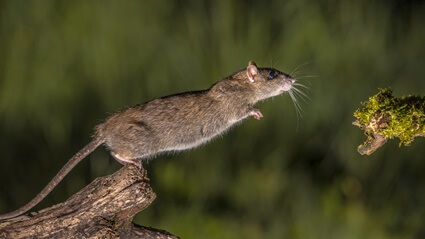
Can Pet Rats Breed With Wild Rats?
Although they’re from different species, pet rats and wild rats can breed and produce viable offspring. Both species come from the same evolutionary family, Rodentia.
Pet rats rarely interact with wild rats, so there’s little chance of mating unless you capture a wild rat and bring it home. The likelihood is still low since wild rats struggle to adapt to captivity.
The constant exposure to light and sound and the lack of hiding places will cause the wild rat to become stressed and die prematurely. Even if the rat survives, it may still experience reproductive failure.
According to the American Association Of Laboratory Animal Science, stress reduces fertility, affecting the reproductive performance of rats. This means wild rats in captivity struggle to breed.
If domesticated and wild rats breed successfully, they’ll produce abnormal baby rats (pups). These pups can grow up, breed, and normalize the line after successive generations.
Can Domesticated Rats Survive In The Wild?
Domesticated rats can’t survive in the wild.
Their adaptability is poor, and they lack the necessary skills and instincts for survival. The wild traits of pet rats have been phased out through generations of selective breeding and captivity.
Pet rats have evolved to live in captivity, and they can’t go backward in their evolution. Likewise, pet rats are used to being fed and pampered by their human owners.
Domesticated rats are used to living in warm cages with food, bedding, and water bedding to make them comfortable. They have to contend with snow, heavy rain, wind, and ice in the wild.
Releasing pet rats into the wild also will expose them to predators, including:
- Snakes.
- Raccoons.
- Bobcats.
- Foxes.
- Weasels.
- Large birds of prey.
Wild rats may attack domesticated and eventually succumb to injuries.
So, it’s vital to recognize that pet rats and wild rats are entirely different creatures.

